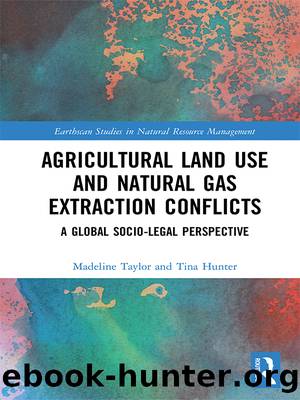Agricultural Land Use and Natural Gas Extraction Conflicts by Taylor Madeline;Hunter Tina; & Hunter Tina

Author:Taylor, Madeline;Hunter, Tina; & Hunter, Tina [Taylor, Madeline & Hunter, Tina]
Language: eng
Format: epub
Publisher: Taylor & Francis Group
8 New York State, USA
Introduction
Shale gas extraction and exploration in the USA is longstanding, having been in operation since 1825 in New York State. Thus, legislative and policy issues in the USA, as a âmature Stateâ for shale gas, are much more developed in some aspects than in other jurisdictions, such as Australia and China. However, it was not until the development of âslickwaterâ hydraulic fracturing by George Mitchell in Texas, in the decade from 1997, that shale gas became a âgame changerâ to the USA.1 As of 2017, unconventional gas now equates to 60 per cent of total USA natural gas production.2 This rapid increase has been attributed to the advent of slickwater hydraulic fracturing techniques, coupled with the injection of chemicals and water to âfractureâ the shale rock and produce unconventional gas.3
The expansion of hydraulic fracturing in the USA has led to a plethora of diametric regulatory positions amongst the states. States such as Texas and Pennsylvania have rushed to embrace shale gas through an adaptive management approach. This has encouraged exploitation, positioning shale as a transition fuel during the shift from oil and coal burning to energy generation from carbon-free sources. This is contrary to the position of other states, such as New York, which have chosen to place a permanent ban on hydraulic fracturing. This ban is based on the negative findings associated with hydraulic fracturing on rural communities, the environment and public health implications stemming from potential contamination of the Catskill Water Table.4 The Marcellus shale formation is the main source of natural gas production in the USA and is located underneath the states of New York, Pennsylvania, West Virginia and Ohio.5 In 2015, after a 7-year review, the state of New York permanently banned all hydraulic fracturing activities of shale gas in its regional jurisdiction of the Marcellus play. The socio-legal environment that led to the ban in New York State, compared with the adaptive and market-led regulation of neighbouring state Pennsylvania,6 demonstrates the application of the precautionary principle.
This chapter presents an analysis of application of the precautionary principle to hydraulic fracturing activities in New York State. It explores the regulatory enactment of the state-wide ban on hydraulic fracturing, before analysing the regulatory response of rural communities in the adoption of the Municipal Home Rule. The implementation of the Municipal Home Rule, by banning oil and gas activities, has effectively empowered rural communities to pass self-administered laws for the protection and enhancement of their general welfare.7 An example of self-regulation is the Joint Landholders Coalition Of New York (JLCNY), which demonstrates the power of collective action as landholder groups collectively negotiate community oil and gas leases. The New York experience provides important and salutary examples of the role played by local communities in influencing the trajectory of state government legislation in response to the challenges of shale gas industrial activity.
Download
This site does not store any files on its server. We only index and link to content provided by other sites. Please contact the content providers to delete copyright contents if any and email us, we'll remove relevant links or contents immediately.
Killers of the Flower Moon by David Grann(3761)
Machine Learning at Scale with H2O by Gregory Keys | David Whiting(3666)
Oathbringer (The Stormlight Archive, Book 3) by Brandon Sanderson(2661)
Will by Will Smith(2595)
Once Upon a Broken Heart by Stephanie Garber(2540)
Guns, Germs and Steel by Diamond Jared(2206)
Borders by unknow(2122)
It Starts With Us (It Ends with Us #2) by Colleen Hoover(2059)
The Room Where It Happened by John Bolton;(2038)
Friends, Lovers, and the Big Terrible Thing by Matthew Perry(2018)
The Color of Law by Richard Rothstein(1824)
HBR's 10 Must Reads 2022 by Harvard Business Review(1703)
The Strength In Our Scars by Bianca Sparacino(1702)
A Short History of War by Jeremy Black(1679)
Water Rights and the Environment in the United States by John Burch(1607)
Examples & Explanations: Administrative Law by William F. Funk & Richard H. Seamon(1557)
515945210 by Unknown(1525)
Pharmacy Practice and The Law by Richard Abood(1497)
That Every Man Be Armed by Stephen P. Halbrook(1482)
